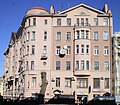Konstantin Nikolajewitsch de Rochefort
Konstantin Nikolaevich de Rochefort ( Russian Константин Николаевич де Рошфор * August 26 . Jul / 7. September 1875 greg. In Tula , † 31 January 1961 in Paris ) was a Russian architect .
Life
Rochefort, son of the architect Nicolas de Rochefort , graduated from the First Cadet Corps in St. Petersburg (graduated in 1895) and the St. Petersburg Institute for Civil Engineers (graduated in 1900). He then served in the Ministry of Agriculture and State Property. Later he was the architect of the St. Petersburg city government and the school for the deaf and mute .
Before and during his studies, Rochefort had his father build the palace in Białowieża (1889-1894) for Alexander III. and in 1895 in St. Petersburg with the renovation of the Nikolai Palace built by eclecticism architect Andrei Iwanowitsch Stackenschneider from 1853–1861, which now houses the Xenija Alexandrovna Institute for Women. These works were considered to be the first examples of Moscow Modernism based on Art Nouveau . Rochefort built 12 apartment buildings on it in the style of Moscow Modernism. He renovated a house with elements of neoclassicism .
1905-1907 built Rochefort together with Vladimir Alexandrovich Lipski in St. Petersburg, at the Red Bridge on the Moika the first Russian multi-storey department store for Textiles - trading house S. Esders and K. Scheefals . The house was a steel frame building and was considered a clear representative of modernism. In 1911 Rochefort wrote the Nekrolog for Lipski in the architects' magazine Sodtschi No. 35. For MF Trifachin he built a tenement house on the Karpowka from 1910–1911, in which the Central Committee of the CPSU decided the October Revolution . 1911–1912 he built a tenement house on the Griboyedov Canal for WP Lichachev and his own tenement house (Mytninskaya Ulitsa 24, 9. Sovetskaya Ulitsa 39), in which the social democratic faction of the Fourth State Duma met (1912–1917). Rochefort was an elder of the Peter and Paul Church in Sestrorezk .
After the October Revolution , Rochefort emigrated to France in 1921 and lived in Paris with his cousin Maurice de Broglie . He continued working as an architect and built a laboratory for his cousin. In 1923 he founded the parish of the Alexander Nevsky Cathedral in Paris with others . In 1929 he joined the Association for the Recognition of Russia , in whose magazine he published an article in 1934 on the influence of the Old Russian architecture of the north on the development of Russian architecture. In 1935 he became a member of the Union of Patrons of the Commemoration of Emperor Nicholas II. He published in Russian émigré magazines and in Russkaya Mysl . He was chairman and later honorary chairman of the Society of Alumni of the First Cadet Corps. He studied the history of the First Cadet Corps, gave lectures and compiled a library of materials that he gave to the House of the White Warrior in Paris. He published articles on the history of the First Cadet Corps and its graduates, such as Alexander Petrovich Sumarokov (1931).
Rochefort was married to the sister of his colleague Lipski Anna Alexandrowna Lipska (1877-1960). Their first child died in their first year. This was followed by Nikolai (1902–1964), Alexander (1905–1954), who graduated from the École des Ponts ParisTech and received the Croix de guerre as an officer in the French army during World War II , and Konstantin (1908–1983).
Rochefort was buried on the Cimetière de Montmartre in Paris .
In 1995 there was an exhibition on the architecture of Nicolas and Konstantin de Rochefort in St. Petersburg.
Works
Web links
Individual evidence
- ↑ a b Архитекторы Николай и Константин де Рошфор. Новые материалы из архивов Парижа и Петербурга. Международная благотворительная выставка . St. Petersburg 1995.
- ↑ a b Л. Мнухин, М. Авриль, В. Лосская: Российское зарубежье во Франции 1919-2000 . Moscow 2008.
- ↑ Constantin de Rochefort (accessed February 23, 2018).
- ↑ Жерихина Е. И., Яранцев В. Н .: Забытый дворец . In: Санкт-Петербургский университет . No. 2 , 1996.
- ↑ In search of the lost palace in Białowieża National Park (accessed February 22, 2018).
- ↑ Жерихина Е. И., Яранцев В. Н .: Протомодерн в России . In: Штакеншнейдеровские чтения: Тез. докл. научной конференции (Петергоф, 1998) . 1998.
- ↑ a b c Citywalls: Архитектор Рошефор де К. Н., здания (accessed February 23, 2018).
- ^ Au Pont Rouge, St Petersburg (accessed February 23, 2018).
- ↑ The route of the tour depends on the location of the starting point, but it usually includes the sailing along the Moika River, the Fontanka and often a section of the Neva River (accessed February 23, 2018).
- ↑ Lipsky's and Lyapidevsky's (accessed on 23 February 2018).
| personal data | |
|---|---|
| SURNAME | Rochefort, Konstantin Nikolajewitsch de |
| ALTERNATIVE NAMES | Рошфор, Константин Николаевич Де (Russian) |
| BRIEF DESCRIPTION | Russian architect |
| DATE OF BIRTH | September 7, 1875 |
| PLACE OF BIRTH | Tula |
| DATE OF DEATH | January 31, 1961 |
| Place of death | Paris |




